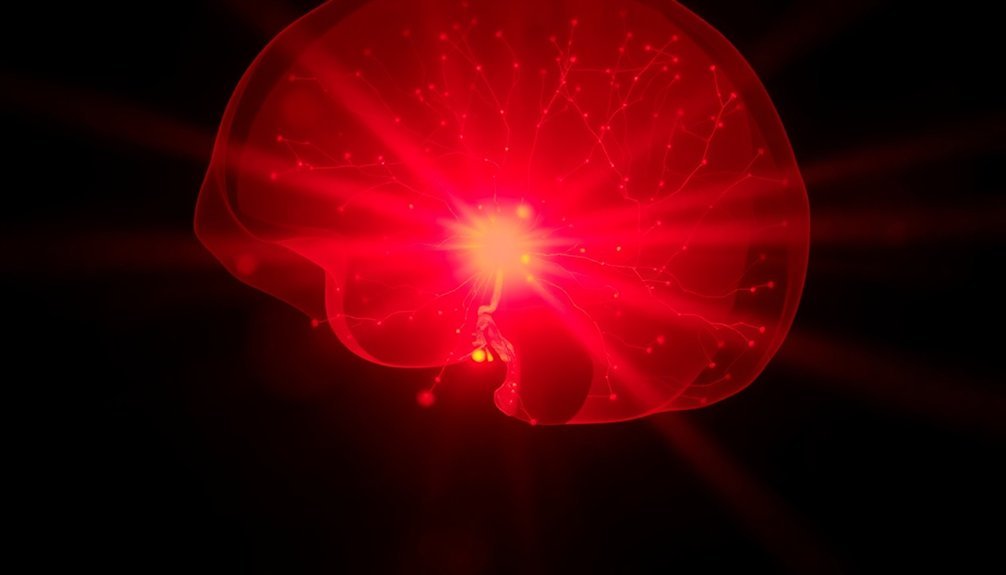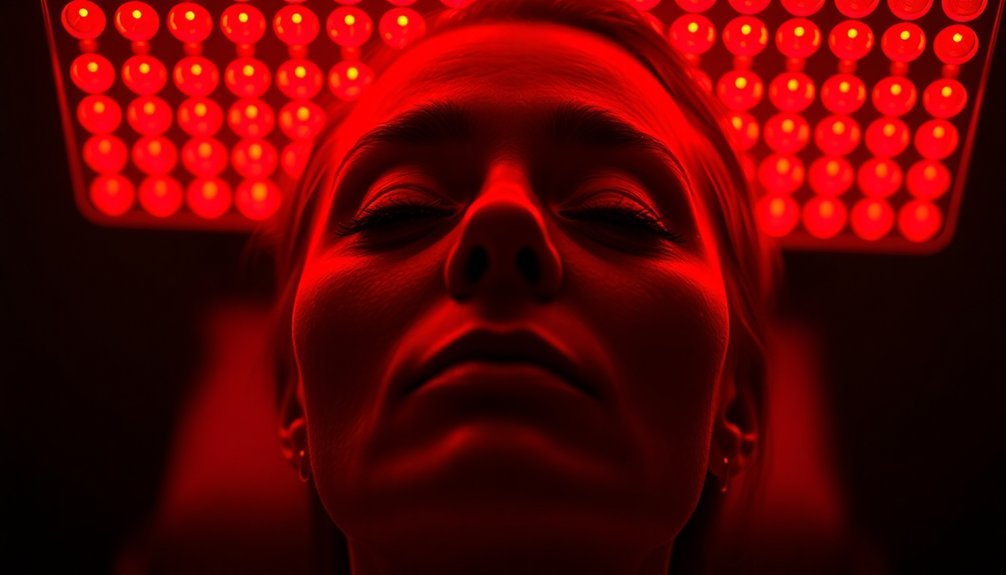Near-infrared therapy can transform your brain's performance through powerful light waves that penetrate deep into neural tissue. You'll experience sharper memory, enhanced focus, and faster mental processing as the therapy boosts ATP production in your brain cells. It reduces inflammation, improves sleep quality, and balances your mood by regulating serotonin levels. The therapy strengthens neural connections, protects brain cells, and enhances mental clarity through improved blood flow and oxygen delivery. By supporting your brain's natural healing mechanisms and energy production, near-infrared therapy offers a revolutionary approach to cognitive enhancement. Discover how these ten brain-boosting benefits can elevate your mental performance.
Enhanced Memory and Focus

While scientists continue to explore new treatments for cognitive decline, near-infrared light therapy has emerged as a promising solution for enhancing memory and mental focus. Research shows that this therapy markedly improves memory performance in both healthy individuals and those with Alzheimer's disease, particularly enhancing working memory and object recognition abilities. A recent study found that just six minutes twice daily of treatment produced significant cognitive improvements.
You'll likely experience improved cognitive performance through several mechanisms. The therapy increases ATP synthesis in your brain cells, boosting energy metabolism and mental processing speed.
It also enhances blood flow to your brain through increased nitric oxide levels, which helps deliver essential nutrients and oxygen to brain tissues. When you're exposed to near-infrared light, it regulates neural oscillations in your hippocampus, a vital region for memory formation.
You can expect improvements in various cognitive tasks, including mathematical processing and delayed memory recall. If you're dealing with cognitive challenges, the therapy's neuroprotective effects might help by reducing inflammation and promoting the growth of new brain cells.
The treatment shows particular promise in addressing memory issues related to traumatic brain injury, dementia, and other neurological conditions.
Faster Mental Processing Speed
Your brain's neural response time gets a significant boost through near-infrared therapy, which delivers 1368 Joules of energy in just six minutes to accelerate mental processing.
The therapy works by optimizing brain signal speed through enhanced ATP synthesis and improved blood flow, leading to faster cognitive responses. Cytochrome c oxidase in your brain's mitochondria absorbs the near-infrared light to drive this enhanced energy production.
You'll notice improvements in reaction times and processing capabilities as the therapy synchronizes brain activity and increases functional connectivity between neural networks.
Neural Response Time Boost
Enhancing mental processing speed stands as one of near-infrared therapy's most promising benefits. Through non-thermal mechanisms, near-infrared light stimulates your neurons and promotes synaptic plasticity, leading to faster cognitive responses. You'll experience improved blood flow to your brain regions and enhanced tissue oxygenation, directly boosting your mental processing capabilities.
When you undergo this therapy, particularly at wavelengths of 808-810 nm, you're activating deeper brain tissue without adverse effects. Studies show that 40 Hz frequency delivers optimal results for improving neural responses and cellular activity. The treatment synchronizes your brain activity and increases functional connectivity, resulting in sharper cognitive performance.
| Benefit | Impact on Your Brain |
|---|---|
| Neural Stimulation | Faster thought processing |
| Blood Flow Boost | Enhanced oxygen delivery |
| Brain Connectivity | Improved neural communication |
| Cognitive Function | Better memory and focus |
Research shows you'll particularly benefit if you're recovering from brain trauma or stroke, as the therapy accelerates healing processes. Clinical studies demonstrate significant improvements in memory, executive function, and overall cognitive ability. The therapy's pulsed light effects can enhance your behavioral performance, while its neuroprotective properties support long-term brain health.
Brain Signal Speed Optimization
Three key mechanisms drive brain signal optimization during near-infrared therapy. First, when NIR light hits your brain cells, it activates cytochrome c oxidase, boosting ATP production and energizing your neurons to fire more efficiently.
Second, the 810nm wavelength penetrates deeply into brain tissue, enhancing functional connectivity between neurons by up to 15% and improving overall signaling speed.
Third, increased cerebral blood flow delivers more oxygen and nutrients to your brain cells, supporting faster neural processing. The enhanced vascular response helps bypass tissue barriers including skin, blood, and bone to maximize therapeutic effects.
You'll experience enhanced brain signaling within minutes of starting treatment, as NIR therapy triggers rapid connectivity improvements through non-thermal mechanisms. The 810nm wavelength proves particularly effective, optimizing your brain's performance through increased BDNF production and NF-kB activation.
These molecular changes promote synaptogenesis and neurogenesis, leading to stronger neural networks and faster signal transmission.
Your brain's processing speed benefits from the therapy's ability to reduce inflammation, decrease cell death, and stimulate mitochondrial function. With fluence levels between 0.9 and 15 J/cm², the treatment optimizes neural pathways across both hemispheres, though you'll notice stronger effects in the directly stimulated areas.
Reduced Brain Inflammation

Near-infrared therapy works to protect your brain cells by targeting inflammation at its source through photobiomodulation.
You'll experience reduced levels of inflammatory markers like TNF-alpha and IL-1β, while beneficial proteins like BDNF increase to support your neurons' health.
This therapeutic approach demonstrates remarkable success in treating traumatic brain injuries by decreasing harmful inflammatory responses and promoting natural healing mechanisms.
Neural Recovery Mechanisms
Recent research has demonstrated that transcranial light therapy directly impacts neural recovery by reducing brain inflammation through multiple pathways. When you undergo near-infrared therapy, particularly at wavelengths of 660nm and 810nm, your brain experiences decreased activation of astrocytes and microglial cells, which are key players in post-trauma inflammation.
The therapy works by stimulating your brain's natural repair mechanisms. You'll benefit from increased production of brain-derived neurotrophic factor (BDNF), which helps your neurons survive and repair themselves.
The treatment reduces pro-inflammatory cytokines while boosting anti-inflammatory ones, creating an environment that protects your neural tissue.
Your brain cells' mitochondria absorb the near-infrared light through cytochrome C oxidase, leading to increased ATP production. This kicks off a cascade of beneficial effects, including the activation of early response genes and enhanced production of reactive oxygen species.
You'll also experience improved circulation through the release of nitric oxide, which helps deliver crucial oxygen and nutrients to your brain cells. These mechanisms work together to reduce inflammation and cell death, ultimately supporting your brain's natural healing processes.
Brain Cell Protection
Light therapy shines through as a powerful defender of your brain cells by dramatically reducing inflammation throughout neural tissues. When near-infrared light at 810nm penetrates your brain tissue, it triggers a cascade of protective mechanisms that shield your neurons from damage.
Your brain's inflammatory response becomes substantially reduced as the therapy calms overactive astrocytes and microglial cells, which are key players in inflammation.
The therapy's cell-protecting effects work through three main pathways:
- Boosting your mitochondria's ATP production, giving your brain cells the energy they need to fight inflammation and repair damage
- Improving blood flow and creating new blood vessels, which helps clear inflammatory markers and delivers essential nutrients
- Reducing oxidative stress while promoting antioxidant processes that protect your neural tissue from further harm
You'll find strong evidence supporting these benefits in both clinical trials and laboratory studies. The therapy's proven track record shows improved recovery from traumatic brain injuries and potential benefits for conditions like Parkinson's disease.
What's particularly remarkable is that these protective effects come without adverse side effects, making it a safe option for long-term brain health maintenance.
Better Sleep Quality
The profound effects of red and near-infrared therapy on sleep quality have revolutionized natural sleep solutions. Unlike blue light, which disrupts your sleep patterns, red light therapy works with your body's natural rhythms to enhance melatonin production and regulate your circadian cycle.
You'll find it easier to fall asleep and maintain consistent sleep-wake patterns when incorporating this therapy into your evening routine.
The therapy's impact extends beyond just helping you sleep. It's actively working to reduce your stress and anxiety levels by triggering the production of endorphins and regulating both serotonin and cortisol. You'll experience improved mood and reduced tension, creating ideal conditions for restful sleep.
What makes near-infrared therapy particularly effective is its ability to enhance brain function while promoting better sleep. It increases blood flow to your brain and activates mitochondrial function, supporting overall neural health.
You'll benefit from improved cognitive performance while maintaining healthy sleep patterns. The therapy's ability to encourage neurogenesis and provide neuroprotection means you're not just getting better sleep – you're also supporting your brain's long-term health and functionality.
Improved Mood Balance

Building on the brain-enhancing benefits of near-infrared therapy, its remarkable impact on mood regulation stands out as a game-changing advantage. By stimulating serotonin production, near-infrared light helps you maintain emotional stability and reduce anxiety levels. You'll experience a natural boost in your mood, particularly during winter months when sunlight exposure is limited.
The therapy's holistic approach to emotional balance works through multiple pathways:
- Direct stimulation of neurotransmitter production with a specific dose of 6.5 J·cm−2, leading to improved mood and reduced drowsiness
- Enhanced brain function through increased cognitive clarity, better verbal memory, and improved learning capabilities
- Regulation of your circadian rhythm, which helps stabilize your emotional responses and reduce mood swings
You'll notice that near-infrared therapy's effects are cumulative, meaning you'll experience progressively better results with regular use.
The treatment's ability to reduce inflammation and oxidative stress in your brain contributes to long-term emotional well-being.
As a non-invasive approach, you can safely use it alongside traditional mental health treatments for thorough mood support and enhanced emotional balance.
Increased Brain Blood Flow
Through advanced photobiomodulation technology, near-infrared therapy substantially boosts cerebral blood flow by triggering the release of nitric oxide in your brain. This increased circulation delivers more oxygen and nutrients to your brain cells, leading to enhanced cognitive function and clearer thinking.
You'll experience these benefits as the therapy stimulates your brain cells' mitochondria, boosting ATP production and overall cellular energy.
Using specific wavelengths between 600-980 nm, near-infrared light penetrates deep into your brain tissue, where it activates essential biological processes. When administered at the correct fluence level of 0.9 J/cm² to 15 J/cm², you'll benefit from direct photobiomodulation effects that improve metabolic function and reduce oxidative stress.
MRI scans confirm that this therapy increases blood flow throughout your brain, which can help generate new neurons and neural pathways. If you're dealing with traumatic brain injury, PTSD, or other neurological conditions, you'll find that near-infrared therapy can markedly improve your executive function and verbal memory.
The therapy's ability to enhance Delta, Theta, and Alpha brainwaves while reducing Beta waves contributes to better overall brain function and healing potential.
Optimal Neural Energy Production

Inside your brain's neurons, near-infrared light therapy triggers a remarkable energy-boosting process by stimulating cytochrome oxidase in the mitochondria. When NIR light penetrates your brain tissue, it donates photons that enhance adenosine triphosphate (ATP) production, your cells' primary energy source.
This increased energy status directly supports neuronal repair, neurogenesis, and the formation of new synaptic connections.
The ideal wavelength of 810 nm has proven most effective for neural energy production, outperforming other NIR wavelengths. You'll benefit most from this specific wavelength because it:
- Penetrates tissue deeply enough to reach mitochondria effectively
- Maximizes ATP production in your brain cells
- Promotes faster recovery and improved functional outcomes
When you undergo transcranial NIR therapy at 810 nm, you're activating a powerful mechanism for enhancing your brain's energy production. This therapy shows promise for various neurological conditions, including traumatic brain injury, Alzheimer's, and Parkinson's disease.
However, since the bioenergetic effects are temporary, you'll need repeated sessions to maintain the beneficial results of this non-invasive treatment approach.
Stronger Brain Cell Protection
Near-infrared light therapy acts as a shield for your brain cells, engaging multiple protective mechanisms that safeguard neurons from damage and death. When NIR light penetrates your brain tissue, it activates cytochrome C oxidase, which not only boosts ATP production but also triggers a cascade of protective responses.
You'll benefit from reduced oxidative stress as NIR therapy enhances your brain's natural defense systems. The light stimulates the production of anti-apoptotic proteins while suppressing signals that would normally lead to cell death.
Through the activation of nuclear factor kappa B (NF-kB), your neurons receive enhanced genetic support for repair and survival.
Research backs these protective effects, with studies showing remarkable results. In models of Parkinson's disease, NIR therapy protected critical dopamine-producing neurons from destruction.
Additionally, brain injury studies demonstrate that regular NIR treatment reduces harmful inflammation by calming overactive immune cells. You'll find that this therapy doesn't just protect existing cells; it creates an environment where your brain can better heal itself.
While researchers continue to optimize delivery methods and treatment protocols, the protective benefits of NIR therapy show tremendous promise for various neurological conditions.
Enhanced Neural Connections

A surge of cellular energy transforms your brain's neural networks when you undergo near-infrared light therapy. As ATP production increases, your brain cells gain the power they need for enhanced signal transmission and formation of new neural connections.
This boost in cellular energy creates an ideal environment for neuroplasticity, allowing your brain to adapt and evolve more effectively.
Your neural connections strengthen through three key mechanisms:
- Reduced inflammation in your brain tissue minimizes harmful astrocyte and microglial activation, creating a healthier environment for neural survival and repair.
- Improved blood flow delivers essential oxygen and nutrients to your brain cells, while promoting the growth of new blood vessels through enhanced nitric oxide release.
- Strengthened neuroprotection shields your neurons from damage while supporting your brain's natural detoxification through enhanced glymphatic system flow.
These combined effects create a powerful synergy that enhances your brain's connectivity. You'll benefit from improved cognitive function as your neural networks become more efficient and resilient. The therapy's ability to foster neural growth while protecting existing connections helps maintain your brain's peak performance over time.
Mental Clarity and Alertness
Near-infrared light therapy can sharpen your focus and concentration by improving blood flow to your brain and supporting the formation of new neural pathways.
You'll notice enhanced mental processing speed, allowing you to think more quickly and tackle complex tasks with greater efficiency.
Your mental clarity will improve as the therapy helps optimize cognitive function, making it easier to maintain alertness throughout the day.
Heightened Focus and Concentration
Maintaining sharp mental focus and clarity is one of the most remarkable benefits of near-infrared therapy. When you're struggling with concentration or mental fog, this therapy enhances your brain's cellular energy production and boosts blood flow, delivering essential oxygen to your neural networks.
You'll experience improved cognitive function as the therapy reduces inflammation and promotes cellular rejuvenation.
Near-infrared therapy supports your brain's natural ability to focus through three primary mechanisms:
- Increased mitochondrial activity that powers your brain cells, leading to enhanced mental performance and sustained concentration
- Improved blood flow and oxygenation that optimize your brain's energy usage and support clearer thinking
- Enhanced neuroplasticity that strengthens neural pathways, making it easier to maintain focus and process information
Whether you're dealing with ADHD, recovering from TBI, or simply seeking to boost your cognitive performance, near-infrared therapy can help. Research shows it's particularly effective at reducing brain fog and improving executive function.
Better Mental Processing Speed
Building on its focus-enhancing properties, near-infrared therapy's impact on mental processing speed stands out as a game-changing benefit. When near-infrared light penetrates your brain tissue, it triggers a cascade of cellular improvements that enhance your mental agility.
Your brain cells receive an energy boost through increased mitochondrial activity, while blood flow and oxygen delivery improve substantially.
You'll notice faster cognitive responses as the therapy enhances your brain's neural efficiency. The light stimulates neurogenesis and strengthens synaptic connections, allowing for quicker information processing and smoother neural communication.
Studies show that regular sessions can improve your ability to think on your feet, make decisions more rapidly, and respond to complex situations with greater speed.
The therapy's anti-inflammatory effects and reduction of oxidative stress further support your brain's processing capabilities. Whether you're dealing with brain fog or simply want to optimize your cognitive performance, near-infrared therapy can help.
At wavelengths between 800-1100 nm, the light effectively reaches your brain tissue, promoting lasting improvements in mental processing speed through just 10-minute sessions. This non-invasive approach offers a practical solution for enhancing your cognitive efficiency.
Frequently Asked Questions
How Long Should Each Near-Infrared Therapy Session Last for Optimal Results?
You'll get optimum results with 10-20 minute sessions. Start with shorter sessions if you're new, then gradually increase your time. Follow your device's guidelines and adjust based on your comfort level.
Can Near-Infrared Therapy Be Combined With Other Brain Enhancement Treatments?
Yes, you can safely combine near-infrared therapy with other brain treatments. It's often used alongside traditional therapies to enhance outcomes, improve cognitive function, and speed up recovery through complementary mechanisms like increased blood flow.
Are There Any Age Restrictions for Using Near-Infrared Light Therapy?
While there's no universal minimum age, you'll need medical guidance if you're pregnant, elderly, or under 18. Always consult your healthcare provider, as age-related conditions may affect your suitability for near-infrared light therapy.
How Soon Can One Expect to Notice Cognitive Improvements After Starting Treatment?
You'll likely notice immediate cognitive benefits after just one session, with more substantial improvements over 8 weeks of regular treatment. Long-term benefits become evident after 3 months of consistent use.
Does the Effectiveness of Near-Infrared Therapy Diminish Over Time With Regular Use?
Yes, you'll likely experience diminishing returns over time. While you'll see strong initial benefits, research shows the effectiveness may decrease, and you'll need consistent treatments to maintain improvements in cognitive function.
In Summary
You'll experience remarkable improvements in your cognitive function through near-infrared therapy. Whether you're seeking better memory, faster thinking, or enhanced mental clarity, this powerful treatment works to optimize your brain's performance at the cellular level. By incorporating regular sessions into your wellness routine, you're investing in your brain health and releasing your full cognitive potential for years to come.





Leave a Reply